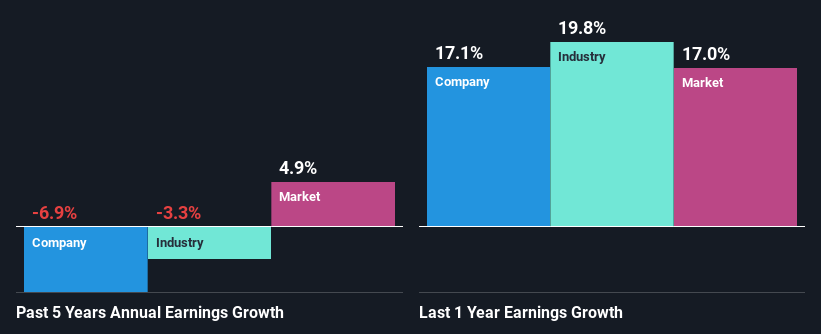The Warehouse Group Limited's (NZSE:WHS) Stock Is Going Strong: Have Financials A Role To Play?
Most readers would already be aware that Warehouse Group's (NZSE:WHS) stock increased significantly by 12% over the past three months. We wonder if and what role the company's financials play in that price change as a company's long-term fundamentals usually dictate market outcomes. In this article, we decided to focus on Warehouse Group's ROE.
ROE or return on equity is a useful tool to assess how effectively a company can generate returns on the investment it received from its shareholders. In short, ROE shows the profit each dollar generates with respect to its shareholder investments.
Check out our latest analysis for Warehouse Group
How Do You Calculate Return On Equity?
Return on equity can be calculated by using the formula:
Return on Equity = Net Profit (from continuing operations) ÷ Shareholders' Equity
So, based on the above formula, the ROE for Warehouse Group is:
16% = NZ$68m ÷ NZ$430m (Based on the trailing twelve months to January 2021).
The 'return' is the amount earned after tax over the last twelve months. Another way to think of that is that for every NZ$1 worth of equity, the company was able to earn NZ$0.16 in profit.
What Has ROE Got To Do With Earnings Growth?
We have already established that ROE serves as an efficient profit-generating gauge for a company's future earnings. Depending on how much of these profits the company reinvests or "retains", and how effectively it does so, we are then able to assess a company’s earnings growth potential. Assuming all else is equal, companies that have both a higher return on equity and higher profit retention are usually the ones that have a higher growth rate when compared to companies that don't have the same features.
Warehouse Group's Earnings Growth And 16% ROE
At first glance, Warehouse Group seems to have a decent ROE. Especially when compared to the industry average of 7.7% the company's ROE looks pretty impressive. For this reason, Warehouse Group's five year net income decline of 6.9% raises the question as to why the high ROE didn't translate into earnings growth. Therefore, there might be some other aspects that could explain this. For example, it could be that the company has a high payout ratio or the business has allocated capital poorly, for instance.
As a next step, we compared Warehouse Group's performance with the industry and found thatWarehouse Group's performance is depressing even when compared with the industry, which has shrunk its earnings at a rate of 3.3% in the same period, which is a slower than the company.
The basis for attaching value to a company is, to a great extent, tied to its earnings growth. It’s important for an investor to know whether the market has priced in the company's expected earnings growth (or decline). This then helps them determine if the stock is placed for a bright or bleak future. If you're wondering about Warehouse Group's's valuation, check out this gauge of its price-to-earnings ratio, as compared to its industry.
Is Warehouse Group Using Its Retained Earnings Effectively?
With a high three-year median payout ratio of 87% (implying that 13% of the profits are retained), most of Warehouse Group's profits are being paid to shareholders, which explains the company's shrinking earnings. With only very little left to reinvest into the business, growth in earnings is far from likely. You can see the 2 risks we have identified for Warehouse Group by visiting our risks dashboard for free on our platform here.
In addition, Warehouse Group has been paying dividends over a period of at least ten years suggesting that keeping up dividend payments is way more important to the management even if it comes at the cost of business growth. Upon studying the latest analysts' consensus data, we found that the company's future payout ratio is expected to drop to 69% over the next three years. As a result, the expected drop in Warehouse Group's payout ratio explains the anticipated rise in the company's future ROE to 24%, over the same period.
Conclusion
In total, it does look like Warehouse Group has some positive aspects to its business. However, while the company does have a high ROE, its earnings growth number is quite disappointing. This can be blamed on the fact that it reinvests only a small portion of its profits and pays out the rest as dividends. With that said, we studied the latest analyst forecasts and found that while the company has shrunk its earnings in the past, analysts expect its earnings to grow in the future. To know more about the company's future earnings growth forecasts take a look at this free report on analyst forecasts for the company to find out more.
This article by Simply Wall St is general in nature. We provide commentary based on historical data and analyst forecasts only using an unbiased methodology and our articles are not intended to be financial advice. It does not constitute a recommendation to buy or sell any stock, and does not take account of your objectives, or your financial situation. We aim to bring you long-term focused analysis driven by fundamental data. Note that our analysis may not factor in the latest price-sensitive company announcements or qualitative material. Simply Wall St has no position in any stocks mentioned.
Have feedback on this article? Concerned about the content? Get in touch with us directly. Alternatively, email editorial-team (at) simplywallst.com.

 Yahoo Finance
Yahoo Finance 
